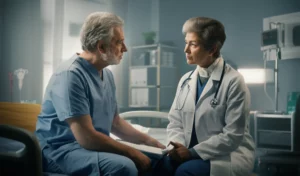Unlocking Anorexia’s Secrets: What Mouse Poop Tells Us About the Gut-Brain Link
Alright folks, let’s dive into something pretty fascinating that’s happening in the world of science. I’ve been digging into this study, and honestly, it’s got me thinking about the incredible complexity of our bodies, especially that mysterious connection between our gut and our brain. We’re talking about Anorexia Nervosa (AN), a really tough and serious illness that messes with how people see themselves and their relationship with food. It hits young women hardest, but it doesn’t discriminate. The tricky part? We still don’t fully get *why* it happens, and the treatments we have – mostly therapy and trying to get folks to eat enough – are limited.
But here’s where it gets interesting. Scientists are starting to look at our gut buddies, the trillions of bacteria living inside us, known as the gut microbiota (GM). Turns out, these little guys are way more important than we thought, influencing everything from our weight to our mood. This has led to a big idea: maybe the gut-brain axis, this constant chat line between our gut and our brain, is involved in AN. Studies have already shown that people with AN have a different mix of gut bacteria compared to healthy folks – a state called dysbiosis. And get this: even if someone with AN gains weight and gets therapy, that gut imbalance often sticks around.
So, the natural next question is: if the gut bugs are different, could they *cause* some of the AN symptoms? And could changing those gut bugs help? That’s where Fecal Microbiota Transplantation (FMT) comes in – basically, taking gut bacteria from one person and putting them into another. It sounds… well, exactly like what it is, but it’s showing promise for various gut-related issues. Could it help with AN?
Setting Up the Gut Swap Shop
This particular study I’m looking at decided to explore this question by using mice. Now, you can’t just give human poop to a regular mouse and expect much to happen; their own gut bacteria are already there, doing their thing. So, the first step was to give the mice antibiotics to clear out their native gut bugs. Think of it like hitting the reset button on their internal ecosystem.
Once their guts were mostly empty, the mice were ready for their new tenants. They received FMT from either people with AN or healthy control donors. This was the first round of transplants (FMT1). The researchers watched the mice closely, checking their food intake, body weight, and even how they behaved.
But here’s the really clever part: they used a cross-over design. After a break with more antibiotics to wash out some of the first transplant’s effects, they did a second round of FMT (FMT2). Some mice got the same type of donor again (AN-AN or CO-CO), while others got the *opposite* type (AN-CO or CO-AN). This was super smart because it allowed them to ask: if a mouse got AN gut bugs first, could getting healthy gut bugs second help reverse some of the effects? And vice versa? It’s like a little experiment in gut-based recovery!
What We Found: The Nitty-Gritty
Let’s get straight to the results.
First off, body weight. And… drumroll please… there wasn’t a significant difference in body weight between the mice who got AN-GM and those who got CO-GM, not after the first FMT round, and not after the second, even with the cross-over. This is a bit different from some other mouse studies, which is interesting and highlights how complex this is. Maybe it’s about the specific mouse strain, their age, or other factors.

Now, food intake. This is where things got noticeable. After the first FMT, the cages of mice that received AN-GM ate less food compared to the CO-GM mice. It wasn’t a huge difference, only a few percent, but over time, even a small reduction can add up. After the second FMT, the pattern continued: mice who got AN-GM twice (ANAN) still ate less than those who got CO-GM twice (COCO). What about the cross-over groups? They showed intermediate levels of food intake, seeming to be influenced more by the *last* type of donor they received. This is pretty cool because it hints that changing the gut bugs *can* change eating behavior, and maybe, just maybe, swapping in healthy bugs could encourage more eating.
The Gut Bugs and Appetite Signals
To understand *why* food intake might be different, the researchers looked at appetite-related hormones in the mice’s blood at the end of the study. And guess what? Mice who received AN-GM twice (ANAN) had significantly higher levels of two hormones: PYY and leptin. These hormones are known to make you feel full and suppress appetite. This fits nicely with the lower food intake observed in these mice. It suggests that the AN gut bacteria might be influencing the production of these hormones, sending stronger “I’m full” signals to the brain via that gut-brain axis we talked about. Interestingly, ghrelin, a hormone that *increases* appetite, trended higher in the groups that received CO-GM.
The Gut Bugs Themselves
Of course, they also looked at the gut bacteria themselves. The antibiotics did a good job of clearing out the original mouse bacteria. After the first FMT, the mice’s gut communities shifted to look more like their human donors (either AN or CO), but still distinct from the original mouse community. And importantly, after FMT1, the gut bacteria composition was significantly different between the AN-GM mice and the CO-GM mice. They found differences in the abundance of certain bacterial groups like Ruminococcaceae, Lachnospiraceae, and Faecalibacterium, which have been linked to AN in humans. They also spotted differences in genera like Bilophila and Clostridium.
After the second FMT, things got a bit less clear-cut, possibly because the groups were smaller or the second FMT period was shorter. They didn’t see statistically significant differences between the groups based on the combined donors, though there were still differences between the two separate experimental runs they conducted, which is something to keep in mind.
Mouse Behavior
They also checked how active the mice were using an “open field” test. In one of the experimental runs, the mice that received AN-GM after the first FMT were less active and moved around less compared to the CO-GM mice. This is intriguing. Could the AN gut bugs be making the mice feel less energetic or perhaps more anxious (though anxiety wasn’t specifically measured in this test)? If mice with AN-GM are less active, that could also help explain why they didn’t lose weight despite eating less – they might be burning fewer calories. However, this behavioral difference wasn’t seen after the second FMT, and overall, all the mice became less active over the course of the study, regardless of which gut bugs they had.
Putting It All Together
So, what’s the big takeaway from this mouse adventure? It looks like transferring gut bacteria from people with Anorexia Nervosa to antibiotic-treated mice *can* influence their behavior, specifically leading to lower food intake and altered appetite signals (higher PYY and leptin). This supports the idea that the gut microbiota plays a role in AN, likely by talking to the brain.
And here’s the hopeful part: the results from the cross-over design, while not always statistically significant due to group sizes, suggest that giving mice gut bacteria from a healthy donor *after* they’ve received AN-GM might help counteract some of those effects on food intake.

A Few Caveats
Like any good study, this one has its limitations. It was done in mice, and mice aren’t tiny humans. We can’t directly translate these findings to people, but they give us valuable clues. Also, the differences between the two experimental runs they did highlight how sensitive these studies can be. They also didn’t measure exactly how well the human bacteria “took” in the mice’s guts.
Looking Ahead
Despite the limitations, this research adds to the growing evidence that the gut microbiota is involved in AN. The fact that AN-GM seemed to influence food intake and appetite hormones in mice, and that a healthy GM might help reverse this, is pretty exciting. It opens the door a little wider to the possibility that targeting the gut microbiota, perhaps through FMT from healthy donors, could become a supportive treatment option for Anorexia Nervosa in the future. It’s not a cure, but anything that could help individuals struggling with this severe illness is definitely worth exploring.
Source: Springer







